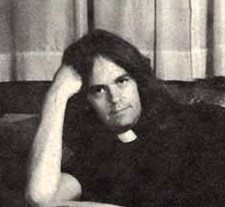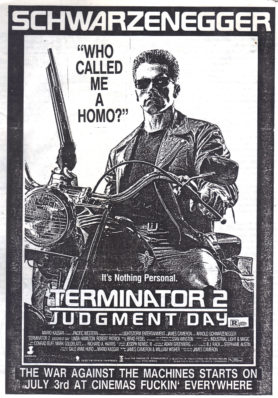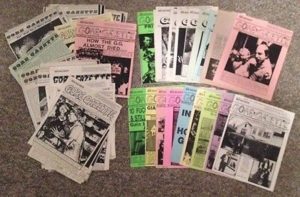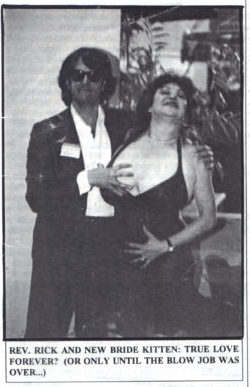It was quite a shock to hear of the passing of Rick Sullivan, a pivotal figure in the horror world, on December 18, 2017. I’m tempted to write that Sullivan’s death, at age 62, marked the end of an era, but the era in question actually ended two decades earlier.
Sullivan was the brains behind the legendary fanzine GORE GAZETTE, and one of the “holy trinity” of 1980s and 90s horror movie zine editors, along with SLEAZOID EXPRESS’ Bill Landis and PSYCHOTRONIC’s Michael Weldon. In the pre-internet era such publications offered a pleasingly down-market alternative to the corporate-friendly genre mags of the time (STARLOG, FANGORIA, FANTASTIC FILMS, etc.) and helped give rise to the zine culture that reached its apex in the nineties.
Sullivan was in many respects the most hermetic and uncompromising of the trinity, staunchly maintaining his gritty east coast attitude and DIY aesthetic. GORE GAZETTE initially consisted of typewritten reviews printed on Xeroxed sheets of paper, and continued in that format for the remainder of its existence. The glossy packaging and famous folk interviews that overtook Psychotronic never happened with GORE GAZETTE, although Sullivan did attempt to branch out via a VHS interview series called GORGON VIDEO that only lasted four episodes and a short-lived New Jersey video store. More lasting were the weekly “GORE GAZETTE Presents” film screenings Sullivan put on at NYC’s The Dive in the early to mid-eighties, during which, according to one source, “the audience would always have a great time, with some members loudly cracking jokes…On some nights (Sullivan) would bring in one of the cast members or even the director of a particular movie to do a Q&A.” Not being a New York resident, or old enough to buy a ticket, I obviously missed out on those screenings.
In fact, my own history with the GORE GAZETTE began late in its existence—in 1991, to be exact, when the zine reached a plateau of sorts by attaining nationwide distribution through Tower Records. The first issue to be distributed thusly was number 105, which showcased Sullivan in fine form with acerbic yet genuinely witty rants about FANGORIA’s Michael Gingold, who incurred Sullivan’s wrath by leaving him out of a GOREZONE article about horror zines, and Carolco, who demanded that Sullivan run a belated ad for TERMINATOR 2—which he did, in a specially altered “G.G.-ized” variant that may be one of the premiere examples of photoshopping. I must say I enjoyed the Hell out of this issue back in ‘91, having no idea that the Gore Gazette was nearing the end of its run.
GORE GAZETTE was started back in 1980 by Sullivan, with the printing chores accomplished by the copy machine in his place of employment. In Sullivan’s own words, the zine “pandered to the prurient interests of big tits, fine bush, masturbation, excessive drinking and psychological immaturity,” with its overriding subject being exploitation movies, which Sullivan wrote about with a passion and enthusiasm fully befitting his self-bestowed title of “Reverend.” Such dedication to grade-B fare was quite rare in 1980, and predated the fame of like-minded figures like Joe Bob Briggs and Chas. Balun (whose signature term “Chunkblower” was actually conceived by Sullivan). That passion was a quality the GORE GAZETTE never lost, even as it grew increasingly raunchy and outrageous.
That Sullivan fancied himself the Howard Stern of the horror scene was made explicit in a letter he wrote to the VILLAGE VOICE, in response to an editorial that accused him of racism: “My list of nationwide subscribers is made up of people of all ages, races, creeds and colors who enjoy my Howard Stern-like banter.” The Stern comparison was furthered in enthusiastic transcriptions of prank calls Sullivan made to Tobe Hooper and other genre luminaries, and lots of miscellaneous trash talk—as Sullivan told an adversary: “Why don’t you carefully roll up this edition of G.G. and “pack” it straight up your ass, you trouble-making, rotund, drug-addled, lying, stealing, fey-voiced, greaseball motherfucker!”
Polite this guy wasn’t. His sensibilities were sharp and overt, especially in the later issues of GORE GAZETTE, when Sullivan really let his id run wild in lengthy editorials and hilariously profane reviews (about 1992’s SLEEPWALKERS: “if the alluring Alice Krige as the son-humping mama sleepwalker doesn’t have you spewing your ballsauce all over the seat of the guy in front of you, maybe you just aren’t whacking it hard enough!”). Yet the wit, intelligence and, unexpectedly enough, morality (in the “Goredom’s Most Wanted” sections that called out bad behavior amid the horror set) of Sullivan’s writing registered every bit as strongly as the vitriol.
On the downside was the frequently libelous content, notably the reckless labeling of Sullivan’s enemies as child molesters. Sullivan certainly had quite a few enemies in the final days of his zine, due to his unfortunate penchant for picking fights with fellow fanzine editors. That penchant, like most everything else about the GORE GAZETTE, went into overdrive in the final issues, with Sullivan hurling slanderous insults at Tony Timpone, Craig Ledbetter, Tim Lucas, Chris Gore, Michael Gingold and many others. Such content is the reason that, unlike many like-minded zines from the eighties and nineties (such as SLIMETIME), the GORE GAZETTE ’s texts have never been reprinted in any format, and likely never will be.
The sense of abandonment permeating GORE GAZETTE’s later issues would appear to be an acknowledgment that the end was nigh. Clearly the demise of the grindhouse so beloved by Sullivan had a sizable effect on GORE GAZETTE’s fortunes, as did the burgeoning zine scene of the nineties, which saw the rise of GORE GAZETTE inspired fringe culture journals like HAPPYLAND and BLACKEST HEART that outdid their inspiration in nastiness, if not quality. Most damaging of all, I’d say, was the onset of the politically correct era, which obviously wasn’t too kind to Sullivan’s prose.
Yet the true impetus of the GORE GAZETTE’s dissolution was something else entirely. Apparently it had to do with the “Private Library” of grey market videos with which Sullivan supplemented his income. As explained by Sullivan in an interview on the 2016 Severin Films DR. BUTCHER, M.D. Blu-ray, he was nearly thrown in jail for including some Traci Lords porno flicks in his listings. The resulting melee led Sullivan to cease publication of the GORE GAZETTE and abstain from virtually all activity in the horror-sphere, a stance that lasted until his death.
Of Rick Sullivan’s final 22 years not much is known. The private library was turned over to GORE GAZETTE staffer Mike Decker, who rechristened it JUST FOR THE HELL OF IT, in which form it continues to operate today (complete with a nifty tribute to GORE GAZETTE on its website). Sullivan himself made an appearance on Troma’s COMBAT SHOCK special edition DVD, as well as the aforementioned Severin Films DR. BUTCHER, M.D. Blu-ray, but otherwise kept out of sight. He declined to be interviewed for the 2013 tome XEROX FEROX: THE WILD WORLD OF THE HORROR FILM FANZINE, making for a rare absence in an otherwise admirably exhaustive recounting of the horror movie zine scene.
One thing I have heard about Sullivan’s later years was that he spent them in a contented and non-controversial manner amid friends and family. So the Rick Sullivan story, despite its shockingly abrupt ending, can at least be said to have a positive arc, with the demons that drove him in the GORE GAZETTE days soundly put to rest.




